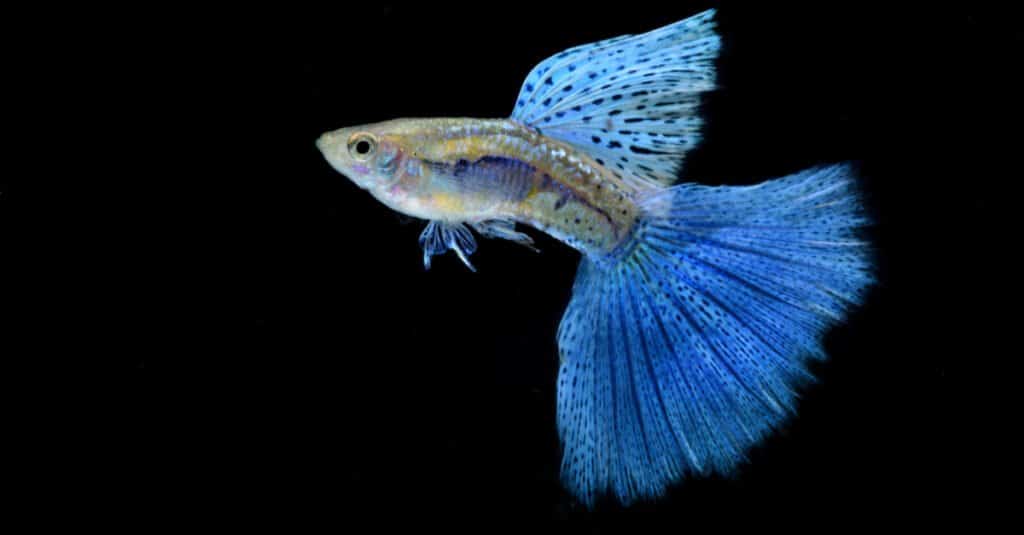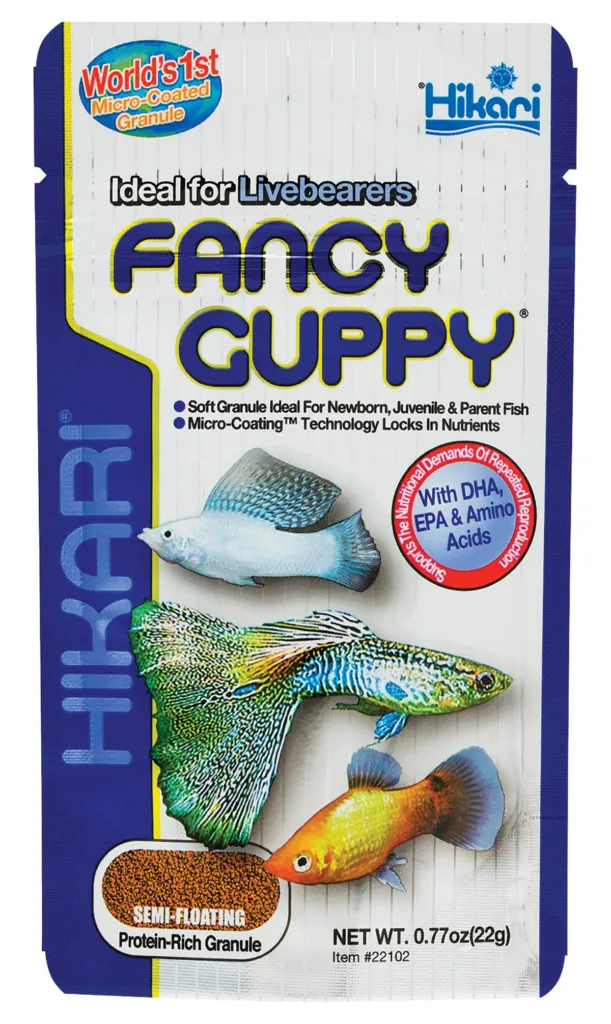Blue leopard guppy are a tropical freshwater fish that are a beautiful and popular breed of guppy fish. They are known for their striking blue and black coloration, which is often speckled or spotted. Blue leopard guppies are relatively easy to care for, making them a good choice for both beginners and experienced aquarists alike.
Blue Leopard Guppy Care Guide for beginners
Blue Leopard Guppy Care Guide for Beginners, Blue leopard guppies are a beautiful and popular breed of guppy, known for their striking blue and black coloration. They are also relatively easy to care for, making them a good choice for beginner aquarists.
What is a blue leopard Guppy
Blue Leopard Guppies are renowned for their unique and mesmerizing mosaic patterns. These fish exhibit a stunning blend of vibrant blue and silver colors, which form intricate spots and streaks on their bodies. The mosaic pattern is reminiscent of a leopard’s spots, hence the name.
Key Features of Blue Leopard Guppies:
| Characteristic | Description |
|---|---|
| Body Color | Predominantly blue with silver mosaic patterns |
| Size | Typically 1.5 to 2.5 inches (3.8 to 6.4 cm) |
| Lifespan | 2 to 3 years, but with proper care, longer |

The mosaic appearance of Blue Leopard Guppies is what makes them so desirable for aquarium enthusiasts. As these patterns are highly variable, each guppy is essentially a unique work of art. When selecting Blue Leopard Guppies for your tank, look for individuals with clear, well-defined patterns. A healthy guppy will have vibrant colors and no signs of discoloration or fin damage.
Origin of Blue Leopard Guppy
Blue Leopard Guppies, like other guppy variants, are native to the freshwater streams and rivers of South America. They belong to the Poeciliidae family and were first discovered in Venezuela and Trinidad. Over time, guppies have been selectively bred to achieve various color variations, including the striking blue and silver mosaic pattern found in the Blue Leopard Guppy.
These fish have become an iconic species in the aquarium hobby, thanks to their adaptability and captivating appearance. While they originated in the wild, they are now bred in captivity to showcase their distinct colors and patterns.
Aquarium Setup for Blue Leopard Guppies
Setting up the right environment is crucial for the health and well-being of your Blue Leopard Guppies. Here are some key considerations for their tank setup:
1. Tank Size:
- A 10 to 20-gallon aquarium is suitable for a small group of Blue Leopard Guppies. Make sure to consider the number of guppies you plan to keep.
2. Water Parameters:
- Maintain a temperature range of 75-82°F (24-28°C).
- Keep the pH level around 7.0, which is close to neutral.
- Ensure that the water hardness is between 10-15 dGH.
3. Filtration and Aeration:
- Blue Leopard Guppies thrive in well-oxygenated water. Use a gentle filter and consider adding an air pump to enhance oxygen levels.
4. Substrate and Decor:
- Fine gravel or sand is ideal for the substrate.
- Provide hiding spots and aquatic plants for shelter and breeding.
- Use smooth decorations to prevent injury to their delicate fins.
5. Lighting:
- Blue Leopard Guppies do well with moderate to low lighting. Avoid excessive brightness, which can cause stress.
6. Water Quality:
- Regular water changes (about 25% every 2 weeks) are essential to maintain water quality and remove waste.
7. Tank Mates:
- Blue Leopard Guppies are peaceful fish. They can coexist with other peaceful species like neon tetras, platies, and mollies. Avoid aggressive or fin-nipping tank mates.
Proper tank setup is the foundation for the health and happiness of your Blue Leopard Guppies. Monitoring water parameters and ensuring a stable, clean environment will contribute to their overall well-being.
Breeding Blue Leopard Guppy

Breeding Blue Leopard Guppies is relatively straightforward, making them an excellent choice for aquarists interested in witnessing the miracle of life in their tanks. Here’s how you can get started: (How to Breed Guppies: A Comprehensive Step By Step Guide)
1. Male-Female Ratio:
- Maintain a ratio of one male to two or three females to prevent overaggressive courting behavior.
2. Gestation Period:
- Female Blue Leopard Guppies are livebearers, which means they give birth to fully formed fry. The gestation period is approximately 26-31 days.
3. Separation of Fry:
- Once the female gives birth, promptly transfer the fry to a separate breeding tank to protect them from adult guppies’ potential cannibalism.
4. Feeding Fry:
- Offer powdered or liquid fry food, infusoria, or finely crushed flakes to the newborn guppies until they are large enough to eat standard fish food.
5. Water Conditions:
- Maintain clean water conditions in the breeding tank to promote the health and growth of the fry. (Guppy Fish Tank Maintenance for Beginners: How to get Crystal Clear Water In your Guppy Tank)
6. Growth and Development:
- Blue Leopard Guppy fry will develop their distinctive mosaic patterns as they mature. This process may take several weeks.
Breeding Blue Leopard Guppies can be a rewarding experience, especially when you see the vibrant colors and patterns emerging in the young fish.
Feeding Blue Leopard Guppies

Feeding your Blue Leopard Guppies a balanced and nutritious diet is essential to maintain their health and vibrant colors. These fish are omnivores and have specific dietary requirements: (Best Guppy Food: Pellet, Flake, and Homemade Options)
1. High-Quality Flakes and Pellets:
- Provide high-quality flake and pellet foods as the primary diet. Look for those specifically formulated for guppies.
2. Live and Frozen Foods:
- Offer occasional treats such as brine shrimp, daphnia, and bloodworms. These live and frozen foods mimic their natural diet and enhance their colors.
3. Feeding Schedule:
- Feed small amounts 2-3 times a day, only what the fish can consume in a few minutes. Avoid overfeeding, which can lead to water quality issues.
4. Variety is Key:
- Rotate their diet to ensure a wide range of nutrients. This helps maintain their health and vitality.
5. Vegetables:
- Blue Leopard Guppies also benefit from the occasional serving of blanched vegetables like spinach or zucchini.
Proper feeding is a cornerstone of Blue Leopard Guppy care. A varied and balanced diet will keep them in prime condition and enhance the vibrancy of their mosaic patterns.
Diseases and Health Care for Blue Leopard Guppies
Maintaining the health of your Blue Leopard Guppies is paramount for their well-being and the preservation of their captivating mosaic appearance. Here are some common diseases to watch out for and essential care tips:
Common Diseases
- Ich (White Spot Disease): This parasitic infection is characterized by small white cysts on the fish’s skin and gills. It’s highly contagious and can be fatal if left untreated. Treat with anti-parasitic medications and raise the water temperature slightly to speed up the life cycle of the parasite.
- Fin Rot: Blue Leopard Guppies can be susceptible to fin rot, which manifests as ragged or decaying fins. Maintain excellent water quality, and treat with antibiotics if needed.
- Dropsy: Dropsy is a symptom of internal organ failure and is characterized by a swollen, bloated appearance. Unfortunately, it’s often challenging to treat, and prevention through good water quality is key.
- Velvet Disease: Velvet appears as a gold or rust-colored dust on the fish’s skin. It is caused by a parasite and requires treatment with copper-based medications.
- Constipation: Overfeeding or improper diet can lead to constipation. To alleviate this issue, provide a diet with more fiber, such as peas with the skin removed.
Maintaining Good Health
- Quarantine New Fish: Before introducing new fish to your established tank, quarantine them for at least two weeks in a separate tank. This helps prevent the introduction of diseases.
- Observe Behavioral Changes: Pay attention to any unusual behavior, such as decreased activity, isolation, or loss of appetite. These can be early indicators of health issues.
- Water Quality: Regular water changes, a well-maintained filter, and appropriate water parameters are vital for preventing diseases.
- Isolate Sick Fish: If you notice a guppy with signs of illness, isolate it in a hospital or quarantine tank to prevent the spread of disease.
- Consult with a Veterinarian: If you’re uncertain about the health of your Blue Leopard Guppies, consult with a veterinarian who specializes in fish care.
Enhancing Mosaic Patterns
Part of the allure of Blue Leopard Guppies is their striking mosaic appearance. If you want to enhance and maintain their beautiful colors and patterns, consider these expert tips:
- Quality Diet: Providing a high-quality and varied diet is the foundation for vibrant colors and patterns. Nutrient-rich foods, such as those rich in carotenoids, can intensify their colors.
- Stress Reduction: Keep your guppies in a low-stress environment. Avoid overcrowding, provide ample hiding spots, and maintain stable water conditions.
- Selective Breeding: If you are passionate about guppy breeding, selective breeding for the most vivid mosaic patterns can yield impressive results over generations.
- Proper Lighting: Adequate lighting that mimics their natural habitat can enhance the colors and patterns. Use full-spectrum or LED lights for the best effect.
- Water Quality: Clean water with minimal ammonia and nitrite levels is essential. Blue Leopard Guppies can lose their colors when stressed by poor water quality.
- Avoid Overbreeding: Overbreeding can lead to reduced quality in offspring. Be selective about breeding pairs to maintain strong mosaic patterns.
Conclusion
Blue Leopard Guppies are a remarkable addition to any aquarium, captivating hobbyists with their mosaic appearance and easy-to-care-for nature. To provide the best care, ensure their tank setup is suitable, understand their origin, and master the art of breeding. Feeding them a balanced diet and maintaining their health are key to preserving their mesmerizing colors and patterns. Keep a close eye on their well-being, and you’ll enjoy the beauty of these fish for years to come. Remember, expert care and attention will help your Blue Leopard Guppies thrive, making them a true gem in your aquatic collection.










